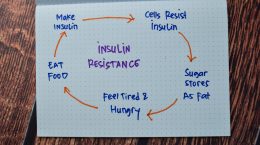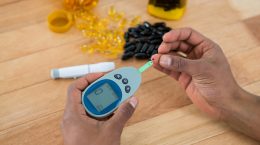Published on May 21, 2024
Latest findings on the health benefits of sun exposure include the potential for improving metabolism and blood sugar control
Key Points
- Research has shown a clear association between vitamin D, metabolic disorders, and diabetes, linking vitamin D to improved insulin resistance, insulin secretion, and beta-cell function and survival, as well as an inverse relationship between vitamin D levels and T2D
- One study with data from 24,098 women and an average follow up time of 11 years found that women with more active sun exposure habits had a 30% lower risk of developing diabetes compared to women who did not actively incorporate sun exposure habits into their lifestyle
- A new study has shown that blood glucose levels were normal for longer among subjects when exposed to natural daylight through windows compared to when they were exposed to artificial light throughout the day; participants were also better able to metabolize fat as an energy source over carbohydrates when being exposed to natural light
 The prevalence of type 2 diabetes (T2D) has been increasing over the past decade, with more than 34 million Americans living with this disease. Insulin resistance, a condition in which cells don’t respond well to or are resistant to insulin, results in high blood sugar levels and is a key component of metabolic syndrome, both of which precede and can predict a future diagnosis of T2D. Insulin resistance and metabolic syndrome are also related to an increased risk of cardiovascular disease, neurodegeneration, and the onset and progression of dementia and Alzheimer’s disease.
The prevalence of type 2 diabetes (T2D) has been increasing over the past decade, with more than 34 million Americans living with this disease. Insulin resistance, a condition in which cells don’t respond well to or are resistant to insulin, results in high blood sugar levels and is a key component of metabolic syndrome, both of which precede and can predict a future diagnosis of T2D. Insulin resistance and metabolic syndrome are also related to an increased risk of cardiovascular disease, neurodegeneration, and the onset and progression of dementia and Alzheimer’s disease.
The Relationship Between Diabetes and Sunshine Goes Beyond Vitamin D
Research has shown a clear association between vitamin D, metabolic disorders, and diabetes, linking vitamin D to improved insulin resistance, insulin secretion, and beta-cell function and survival, as well as an inverse relationship between vitamin D levels and T2D. In other words, the risk of developing insulin resistance and/or diabetes over time increases with lower vitamin D levels.
A study by Lindqvist et al (2010) took note of the relationship between vitamin D and diabetes and aimed to determine if there was also a correlation between sun exposure habits and T2D. Using data from 24,098 women, with an average follow up time of 11 years, the authors found that women with more active sun exposure habits had a 30% lower risk of developing diabetes compared to women who did not actively incorporate sun exposure habits into their lifestyle. The authors concluded that their study “supports that sunlight is involved in the glucose metabolism.”
Is this all related to vitamin D production?
Could there be Other Factors Linking Sunlight Exposure to Reduced Diabetes?
Additional research has shown that those who are outdoors and exposing themselves to sunlight are more likely to be physically active while doing so. In fact, another new study by dos Santos et al. (2023) clearly showed that more sun exposure time among children was related to a lower body mass index (BMI), less body fat, and higher amounts of physical activity. Each of these factors can help lower the risk of metabolic syndrome and T2D, putting into question whether sunlight exposure itself provided much of the benefit.
However, new findings from a study by Habets et al. (2023) may shed additional light on the topic. While their study has not yet been fully published, the poster of results, titled Natural daylight through windows as opposed to artificial lighting during office hours improves glucose control and 24h substrate metabolism in type 2 diabetes patients, were presented in October of 2023 at the annual meeting of the European Association for the Study of Diabetes. The abstract can be found here.
Their study enrolled 13 people who had been diagnosed with type 2 diabetes. Participants were then confined to a research facility for 4.5 days at a time. In a randomized, cross-over fashion, they were either exposed to natural sunlight through windows or artificial light from LED lighting between the hours of 8am and 5pm. The intensity of the natural lighting varied throughout the day while the artificial lighting remained at a constant intensity level. Dim lighting was provided to both groups during the evening time, and sleep was in full darkness.
One month after the first session, participants were confined once again, for another 4.5 days, but with the form of lighting they had not previously been exposed to.
Natural Daylight Exposure vs Artificial Light Shown to Help Regulate Blood Sugar
Findings from this study showed that blood glucose levels were normal for longer when the subjects were exposed to natural light compared to when they were exposed to artificial light throughout the day (59% vs 51% of the time). Additionally, participants were better able to metabolize fat as an energy source over carbohydrates when being exposed to natural light. This study overall shows that exposure to sunlight could help treat and prevent type 2 diabetes by improving metabolism and blood sugar control.
As the authors conclude, “Our findings suggest that exposure to natural daylight positively impacts metabolism and could support the treatment and prevention of metabolic diseases.”
“If you work in an office with almost no exposure to natural light, it will have an impact on your metabolism and your risk or control of type 2 diabetes, so try to get as much daylight as possible, and ideally, get outdoors when you can.” Habetes
Circadian Rhythm Regulation is Associated with Metabolic Health
Disruptions to circadian rhythm have been shown to increase the risk of cancer, heart disease, and metabolic conditions, and as mentioned by the authors of the study above, this could be the reason for their findings. Daytime sunlight exposure helps guide your circadian rhythm by increasing melatonin levels at night which promotes sleep and allows your body enough time to rejuvenate. A healthy, regular circadian rhythm also promotes healthy mood and improved cognition.
Learn more about additional health benefits from full spectrum sunshine exposure, beyond vitamin D production, here or by watching the videos below.
This Sunshine Month, get 10% off your home blood spot test kit plus get our Sunshine eBook for free when using the code SunMonth24 at checkout.
 What happens in your body when it is exposed to sunlight?
What happens in your body when it is exposed to sunlight?
Watch this snippet of a video interview with Dr. Michael Holick, as he describes some of the reactions that happen within the body when it is exposed to sunlight.
 Supplements do not replace sunlight
Supplements do not replace sunlight
Sunlight has more benefits than those provided by UVB and vitamin D. Learn about the different rays found in sunlight and their unique benefits to your health.
 Health Benefits of Full Spectrum Sunlight
Health Benefits of Full Spectrum Sunlight
Wavelengths of Energy from Sunshine: UVB, UVA, Red, Near Infrared, Far Infrared, and Blue Light from sunshine all have unique health consequences…
Are You Getting Enough Vitamin D from Sunshine?
 Having and maintaining healthy vitamin D levels and other nutrient levels can help improve your health now and for your future. Choose which additional nutrients to measure, such as your omega-3s and essential minerals including magnesium and zinc, by creating your custom home test kit today. Take steps to improve the status of each of these measurements to benefit your overall health. With measurement you can then determine how much is needed and steps to achieve your goals. You can also track your own intakes, symptoms and results to see what works best for YOU.
Having and maintaining healthy vitamin D levels and other nutrient levels can help improve your health now and for your future. Choose which additional nutrients to measure, such as your omega-3s and essential minerals including magnesium and zinc, by creating your custom home test kit today. Take steps to improve the status of each of these measurements to benefit your overall health. With measurement you can then determine how much is needed and steps to achieve your goals. You can also track your own intakes, symptoms and results to see what works best for YOU.
Enroll in D*action and Test Your Levels Today!



 What happens in your body when it is exposed to sunlight?
What happens in your body when it is exposed to sunlight? Supplements do not replace sunlight
Supplements do not replace sunlight Health Benefits of Full Spectrum Sunlight
Health Benefits of Full Spectrum Sunlight


